My special
thanks to Roy W0SL, Jim N4ST, Don KD4APP, Darrel AA7FV,
Jim N5JDB, Clive G3CWV, Mike DK3WN, Reinhard DJ1KM +,
Michael DG1CMZ, Oliver DG6BCE, Peter DF2JB, Volker DF7IT,
Jean-Louis F6AGR, Thomas HB9SKA, Christoph HB9HAL, Claudio
IK1SLD, Andreas OE1DMB, Michael PA3BHF, Henk PA3GUO,
Darek SP9TTX, Ricardo PY3VHQ, Keith ZS6TW, Don N4UJW,
Vladimir RA3DQT, Paulo CT1ETE, John KD2BD, Harald DH8HHA,
Maik Hermenau, Ian ZL1AOX, Gerd DL8DR, Michael OH2AUE,
Robert G8ATE, Wouter Jan Ubbels PE4WJ, Mark KF6KYI,
Al W8KHP, Drew KO4MA, Rolf DK2ZF, Dave WB6LLO, Graham
G3VZV, Joe K0VTY, Nils von Storch, Zeljko 9A2EY, Pierre
ZS6BB, Bent OZ6BL, Mariano CT1XI, Al GM1SXX, Luc LU1FAM,
Matt SQ7DQX, Lance K6GSJ, Chris VK3AML, Bob VE6BLD,
Sergej RV3DR, Alex VK5ALX, Rudolf ZS6FX, Dick Daniels
W4PUJ/SK , Bob Patterson K5DZE, Jean-Louis Rault F6AGR,
Ivano Bonesana, Patrick Hajagos, Luc Leblanc VE2DWE,
Mike N1JEZ, John K6YK, Tetsu-san JA0CAW, Marco Bauer,
Carl Lindberg SM6NZV, Philip G0ISW, Kuge-san JE1CVL,
Pat AA6EG, John M0UKD, Paul Marsh M0EYT, Federico Manzini,
Jan PE0SAT, Domenico I8CVS +, Roland Zurmely PY4ZBZ,
Rob Hardenberg PE1ITR, Michael Kirkhart KD8QBA, Davide
D'Aliesio IW0HLG, Francisco EA7ADI, Kubota-san, Noguchi-san
JA5BLZ, Kuge-san JE1CVL, Luciano PY5LF, Wakita-san JE9PEL,
Peter ON4EZJ, Enrico IW2AGJ, Jean-Pierre F5YG, Remco
PA3FYM, Dave G0CER, Jose Maria EA2JX, Viljo ES5PC, Charly
DK3ZL, Bernd DL6IAN, Gustavo LW2DTZ, Juergen DL8SDQ,
Gary ZS6YI, Wilhelm DL6DCA, Bence Szabo, Alex KR1ST,
Branko 9A3ST, Daniel DL7NDR and Michael Hoerenberg for
kindly contributing to this collection ! |
Picture |
Satellite
#NORAD |
Description |
Launch Date |




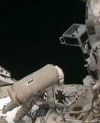

|
ARISSAT-1
RadioSkaf-V
RADIOSKAF-B
KEDRr
RS01S
#37772
(1998-067CK) |
ARISSAT-1 (as it is called in the United
States) respectively RadioSkaf-V (as it is called in
Russia) is part of an amateur radio experiment by the
Radio Amateur Satellite Corp., NASA and the Russian
aerospace company RSC Energia.
It was brought to
ISS on January 30th 2011 aboard
Progress 41. It weighs 30 kg and is housed in a box
with a size of about 55x55x40cm.
The additional
name "Kedr" is in memoriam of the call sign
used by the first person to fly in space, Yuri Gagarin,
who made the historic first human spaceflight nearly
50 years ago on April 12th
1961.
ARISSAT-1 is supposed to transmit 25 greeting
messages in 15 different languages, telemetry as well
as photos of the Earth on  145.950
MHz using the callsign RS01S. 145.950
MHz using the callsign RS01S.
Here is a description
of the band plan including
the transponder-frequencies
for up- and downlink.
Originally it was planned
to release ARISSAT-1 by Russian Cosmonauts during a
spacewalk set for February 16th
2011. However this was postponed and Arissat-1 was finally
released by Russian Cosmonauts Sergei Volkov, RU3DIS,
and Alexander Samokutyaev during an EVA on August 3rd
2011 at 18:43 UTC. It was an exciting event as the release
of the satellite was first stopped because of some uncertainty,
whether the 70cm antenna for the uplink was missing
or broken. It was finally launched towards the end of
the EVA and it turned out that the satellite including
the linear transponder is working fine. |
Aug 3rd
2011 |
First test aboard ISS |
     On
February 10th and 11th
2011, while ARISSAT-1 was still onboard ISS, it was
connected to an antenna mounted outside of ISS and was
tested for 2 days. Enclosed SSTV images and audio recordings
were On
February 10th and 11th
2011, while ARISSAT-1 was still onboard ISS, it was
connected to an antenna mounted outside of ISS and was
tested for 2 days. Enclosed SSTV images and audio recordings
were  received
by DK3WN on February 11th 2011
at 2 passes over Germany around 00:18 UTC and 01:54
UTC. Many thanks to Mike DK3WN for the recordings. received
by DK3WN on February 11th 2011
at 2 passes over Germany around 00:18 UTC and 01:54
UTC. Many thanks to Mike DK3WN for the recordings.
|
 This recording
of SSTV and voice transmissions of ARISSAT-1 was made
by JA0CAW on February 10th
2011 at 21h31 UTC. Many thanks to Tetsu-san JA0CAW for
kindly providing the recording. This recording
of SSTV and voice transmissions of ARISSAT-1 was made
by JA0CAW on February 10th
2011 at 21h31 UTC. Many thanks to Tetsu-san JA0CAW for
kindly providing the recording.
|
Second test aboard
ISS |
 On July
30th and 31st
2011 ARISSAT-1 was once more activated while still onboard
ISS. It was connected to and outside antenna and operated
in low power mode (40sec on every 2 minutes). Its transmission
on 145.950 MHz was also relayed by another station in
ISS to 437.550 MHz. Enclosed audio file was received
and recorded on 437.550 MHz on July 31st
2011 at 03:43UTC by DD1US. Pauses were removed. On July
30th and 31st
2011 ARISSAT-1 was once more activated while still onboard
ISS. It was connected to and outside antenna and operated
in low power mode (40sec on every 2 minutes). Its transmission
on 145.950 MHz was also relayed by another station in
ISS to 437.550 MHz. Enclosed audio file was received
and recorded on 437.550 MHz on July 31st
2011 at 03:43UTC by DD1US. Pauses were removed.
|
 On the
next pass on July 31st 2011
at 05:18 UTC enclosed SSTV transmission in Robot 36
mode, which was again relayed by ISS to 437.550 MHz,
was received by DD1US. On the
next pass on July 31st 2011
at 05:18 UTC enclosed SSTV transmission in Robot 36
mode, which was again relayed by ISS to 437.550 MHz,
was received by DD1US.
|
 On the
same pass enclosed signal was received directly from
ARISSAT-1 on 145.950 MHz. Listen to the English voice
and see whether you can understand the "secret
word" which is changed in each transmission. Received
and recorded on July 31st 2011
at 05:21 UTC by DD1US. Pauses were removed. On the
same pass enclosed signal was received directly from
ARISSAT-1 on 145.950 MHz. Listen to the English voice
and see whether you can understand the "secret
word" which is changed in each transmission. Received
and recorded on July 31st 2011
at 05:21 UTC by DD1US. Pauses were removed.
|
 During
the subsequent pass over Central Europe ARISSAT-1 was
again activated. Marco Bauer was able to receive enclosed
CW and BPSK signals on 145.920 MHz on July 31st
2011 at 06:53 UTC with an Eggbeater antenna. Recording
kindly provided by Marco Bauer. During
the subsequent pass over Central Europe ARISSAT-1 was
again activated. Marco Bauer was able to receive enclosed
CW and BPSK signals on 145.920 MHz on July 31st
2011 at 06:53 UTC with an Eggbeater antenna. Recording
kindly provided by Marco Bauer.
|
 During
the same pass also Mike DK3WN received Arissat-1. His
recording of the telemetry downlink on 145.920 MHz (CW/BPSK)
is of very nice quality. In the first part of the recording
you can decode a telemetry packet using the Arissat-software
and in the second part of the recording you can decode
a KURSK frame. Recorded on July 31st
2011 at 06:54 UTC and kindly provided by Mike DK3WN. During
the same pass also Mike DK3WN received Arissat-1. His
recording of the telemetry downlink on 145.920 MHz (CW/BPSK)
is of very nice quality. In the first part of the recording
you can decode a telemetry packet using the Arissat-software
and in the second part of the recording you can decode
a KURSK frame. Recorded on July 31st
2011 at 06:54 UTC and kindly provided by Mike DK3WN.
|
 The last
pass audible in Central Europe on July 31st
2011 was at 08:30 UTC. In enclosed recording the pauses
were removed. The audio signal includes multiple sections
including the voice telemetry output in English language
and was recorded by DD1US. The last
pass audible in Central Europe on July 31st
2011 was at 08:30 UTC. In enclosed recording the pauses
were removed. The audio signal includes multiple sections
including the voice telemetry output in English language
and was recorded by DD1US.
|
Released August 3rd
2011 at 18:43 UTC |
 Tetsu-san
JA0CAW was one of the first stations who received the
CW/BPSK beacon signal of ARISSAT-1. Recorded on August
3rd 2011 at 20:56 UTC and kindly
provided by Tetsu-san JA0CAW. Tetsu-san
JA0CAW was one of the first stations who received the
CW/BPSK beacon signal of ARISSAT-1. Recorded on August
3rd 2011 at 20:56 UTC and kindly
provided by Tetsu-san JA0CAW.
|
 Tetsu-san
JA0CAW was also able to receive ARISSAT-1 on the next
pass over Japan. Recorded on August 3rd
2011 at 22:33 UTC and kindly provided by Tetsu-san JA0CAW. Tetsu-san
JA0CAW was also able to receive ARISSAT-1 on the next
pass over Japan. Recorded on August 3rd
2011 at 22:33 UTC and kindly provided by Tetsu-san JA0CAW.
|
 On
Friday, August 5th 2011 between
05:20 and 05:30 UTC enclosed downlink signal from Arissat-1
was received On
Friday, August 5th 2011 between
05:20 and 05:30 UTC enclosed downlink signal from Arissat-1
was received  on
145.950 MHz by DD1US/p. The satellite was apparently
not yet spin stabilized and due to its tumbling the
signal exhibits a very strong fading. This can be also
seen in the SSTV picture which was received during this
pass. on
145.950 MHz by DD1US/p. The satellite was apparently
not yet spin stabilized and due to its tumbling the
signal exhibits a very strong fading. This can be also
seen in the SSTV picture which was received during this
pass.
|
  In the
night of August 6th 2011 I
had my receiver monitoring 145.950 MHz and I was able
to capture signals from multiple passes between 01:00
and 04:00 UTC. I submitted my log to the ARISSAT-1 /
KEDR team and received enclosed nice Award. Recorded
by DD1US. In the
night of August 6th 2011 I
had my receiver monitoring 145.950 MHz and I was able
to capture signals from multiple passes between 01:00
and 04:00 UTC. I submitted my log to the ARISSAT-1 /
KEDR team and received enclosed nice Award. Recorded
by DD1US.
|
 Enclosed
3 minute recording was done on 145.950 MHz on August
6th 2011 between 05:54 and
05:58 UTC by DD1US. Enclosed
3 minute recording was done on 145.950 MHz on August
6th 2011 between 05:54 and
05:58 UTC by DD1US.  The
picture shows the corresponding waterfall display of
the downlink spectrum. The IF of 10.7 MHz corresponds
to 145.950 MHz, the CW/BPSK signal at 145.920 MHz can
be seen at the IF of 10.73 MHz. Receiver frequency was
not changed thus you can see the downlink signal changing
frequency due to doppler effect. The
picture shows the corresponding waterfall display of
the downlink spectrum. The IF of 10.7 MHz corresponds
to 145.950 MHz, the CW/BPSK signal at 145.920 MHz can
be seen at the IF of 10.73 MHz. Receiver frequency was
not changed thus you can see the downlink signal changing
frequency due to doppler effect.
|
 In the
night of August 7th I had again
my receiver monitoring 145.950 MHz and I was able to
capture signals from multiple passes between 01:00 and
06:00 UTC. During these passes interference with emissions
form ISS were noticed. You can hear in enclosed recording
by DD1US packet radio emissions from ISS as well as
interference which sounds like feedback. Investigations
are underway. In the
night of August 7th I had again
my receiver monitoring 145.950 MHz and I was able to
capture signals from multiple passes between 01:00 and
06:00 UTC. During these passes interference with emissions
form ISS were noticed. You can hear in enclosed recording
by DD1US packet radio emissions from ISS as well as
interference which sounds like feedback. Investigations
are underway.
|
  This audio
recording and the decoded SSTV picture was received
by Patrick Hajagos on August 29th
2011 at 14:26 UTC. Received on 145.950 MHz in Vienna
using an ICOM IC-R20 receiver and kindly provided by
Patrick. This audio
recording and the decoded SSTV picture was received
by Patrick Hajagos on August 29th
2011 at 14:26 UTC. Received on 145.950 MHz in Vienna
using an ICOM IC-R20 receiver and kindly provided by
Patrick.
|
 5 days
before ARISSAT finally decayed enclosed beacon signal
was received on December 30th
2011 at 11:02 UTC on 145.915 MHz by Matthias DD1US. 5 days
before ARISSAT finally decayed enclosed beacon signal
was received on December 30th
2011 at 11:02 UTC on 145.915 MHz by Matthias DD1US.
|
 At the
same time enclosed SSTV and synthesized voice signal
was received on December 30th
2011 at 11:02 UTC on 145.950 MHz by Matthias DD1US. At the
same time enclosed SSTV and synthesized voice signal
was received on December 30th
2011 at 11:02 UTC on 145.950 MHz by Matthias DD1US.
|
 Also during
the subsequent pass over Europe ARISSAT was heard loud
and clear. SSTV and synthesized voice signal was received
on December 30th 2011 at 13:45
UTC on 145.950 MHz by Matthias DD1US. Also during
the subsequent pass over Europe ARISSAT was heard loud
and clear. SSTV and synthesized voice signal was received
on December 30th 2011 at 13:45
UTC on 145.950 MHz by Matthias DD1US.
|
 Also during
the next pass ARISSAT was received in Europe. SSTV and
synthesized voice signal was received on December 30th
2011 at 15:07 UTC on 145.950 MHz by Matthias DD1US. Also during
the next pass ARISSAT was received in Europe. SSTV and
synthesized voice signal was received on December 30th
2011 at 15:07 UTC on 145.950 MHz by Matthias DD1US.
|
ARISSAT-1 finally decayed on January
4th 2012 at around 7am (+-3
hours). |
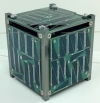
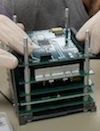

|
AubieSat-1
AS-1
OSCAR-71
AO-71
#37854
(2011-061E) |
AubieSat-1 (AO-71) is
the first student built satellite in Alabama and part
of the ELaNa3 (Educational Launch of Nanosatellites)
Mission. It is a 1U CubeSat (weight is 1.03 kg) entirely
designed, built and tested by Auburn University undergraduate
students, without using components off the shelf. It
will study radio wave propagation through the ionosphere
and test solar panel protective films. AubieSat-1 transmits
a CW (morse code) telemetry beacon with a speed of 20wpm
every minute for a duration of 20 seconds on its UHF
downlink on 437.475 MHz. The tranmit power is 0.7 Watts
EIRP. The uplink frequency is at 145.950 MHz. |
Oct
28th 2011 |
 Henk PA3GUO
received Aubiesat-1 on November 3rd
2011 at 02:14 UTC. Recording kindly provided by Henk
PA3GUO. Henk PA3GUO
received Aubiesat-1 on November 3rd
2011 at 02:14 UTC. Recording kindly provided by Henk
PA3GUO.
|
 On December
28th 2011 at 03:00 UTC Mike
Rupprecht received the CW downlink of AubieSat. Enclosed
recording kindly provided by Mike DK3WN. On December
28th 2011 at 03:00 UTC Mike
Rupprecht received the CW downlink of AubieSat. Enclosed
recording kindly provided by Mike DK3WN.
|

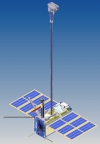
|
RS-39
Chibis-M
#38051
(2011-062C) |
 Chibis-M was released from Progress
M-13M on January 24th 2012
at 23:14 UTC into a circular orbit with an altitude
of about 500km. A scientific downlink is in S-Band around
2270 MHz and a telemetry downlink is in the 70cm
ham radio band at 435.315 MHz (TX A) or 435.215
MHz (TX B). Telemetry is transmitted by a the CW beacon
in Morse Code. If you click on the icon on the right
you will get the information on how to decode the Telemetry. Chibis-M was released from Progress
M-13M on January 24th 2012
at 23:14 UTC into a circular orbit with an altitude
of about 500km. A scientific downlink is in S-Band around
2270 MHz and a telemetry downlink is in the 70cm
ham radio band at 435.315 MHz (TX A) or 435.215
MHz (TX B). Telemetry is transmitted by a the CW beacon
in Morse Code. If you click on the icon on the right
you will get the information on how to decode the Telemetry.
|
Jan
25th 2012 |
 During
its first orbit, only 7 minutes after the satellite
was released, Kuge-san JE1CVL received the CW beacon
of RS-39 at 435.315 MHz on January 24th
2012 at 23:21 UTC. Recording kindly provided by Testu-san
JA0CAW. During
its first orbit, only 7 minutes after the satellite
was released, Kuge-san JE1CVL received the CW beacon
of RS-39 at 435.315 MHz on January 24th
2012 at 23:21 UTC. Recording kindly provided by Testu-san
JA0CAW.
|
On February 7th
2012 it has been reported that the downlink of Chibis-M
had been switched to BPSK. |
Chibis-M also features
an S-band downlink at 2269.98 MHz. This downlink is
occasionally switched on (active times of 2 minutes
15 seconds have been reported). |
  Enclosed
un-modulated carrier of the S-band downlink was received
on February 16th 2012 at 19:45
UTC by Paul Marsh. Recording kindly provided by Paul
M0EYT. Enclosed
un-modulated carrier of the S-band downlink was received
on February 16th 2012 at 19:45
UTC by Paul Marsh. Recording kindly provided by Paul
M0EYT.
|
Enclosed 2 spectrum plots
of the S-band spectrum were recorded on February 22nd
2012 around 17:25 UTC and kindly provided by Paul M0EYT.
 
|
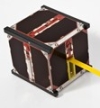
|
MaSat-1
MO-72
Masat-Oscar-72
#38081
(2012-006E) |
MaSat-1 (Magyar Satellite
1) was built at the Budapest University of Technology
and Economics. This nano-satellite has a weight of 1
kg. Its primary purpose is to demonstrate various spacecraft
avionics, including a power conditioning system, transceiver
and on-board data handling. The downlink is at 437.345
MHz in GFSK 625/1250 bps. It also features a CW
(morse code) beacon. |
Feb
13th 2012 |
 Enclosed
audio file was received and recorded on February 17th
at 15:22 UTC by Mike Rupprecht. Recording kindly provided
by Mike DK3WN. Enclosed
audio file was received and recorded on February 17th
at 15:22 UTC by Mike Rupprecht. Recording kindly provided
by Mike DK3WN.
|
 On December
31st 2014 at 17:30 UTC Francisco
EA7ADI received the GFSK signal of MASAT-1. Recording
kindly provided by Francisco EA7ADI. On December
31st 2014 at 17:30 UTC Francisco
EA7ADI received the GFSK signal of MASAT-1. Recording
kindly provided by Francisco EA7ADI.
|
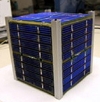
|
Xatcobeo
#38082
(2012-006F) |
Xatcobeo was built in
Spain in a collaboration of the University Vigo and
INTA. This nano-satellite is a 10 cm cube with a weight
of 1 kg. Its mission is to demonstrate software-defined
radio technology and solar panel deployment. Its downlink
is at 437.365 MHz in 1200 bd FFSK with AX.25 protocol
and at 145.940 MHz in SSR (steady state response).
|
Feb
13th 2012 |
 Enclosed
audio file was received and recorded on February 17th
at 15:23 UTC by Mike Rupprecht. Recording kindly provided
by Mike DK3WN. Enclosed
audio file was received and recorded on February 17th
at 15:23 UTC by Mike Rupprecht. Recording kindly provided
by Mike DK3WN.
|
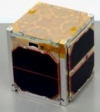
|
PW-Sat
1
#38083
(2012-006G) |
PW-Sat was built at the
Warsaw University of Technology in Poland and is the
first Polish nano-satellite. Its primary mission is
to test a deployable atmospheric drag augmentation device
for de-orbiting Cubesats. PW-Sat carries an FM to DSB
amateur radio transponder with an FM input on 435.020
MHz and DSB output on 145.900 MHz. There are 5 modes
of operation:
- Receive only: no downlink
-
CW Beacon: On-Off Keying (OOK) CW 12 WPM 435.020 MHz
- BPSK Beacon: 1200 bps AX25 (1 frame on 20 sec) 435.020
MHz
- Control communication mode: BPSK 1200 bps
AX25 435.020 MHz
- Voice Repeater (like "AO-16
mode"): uplink 435.020 MHz FM and downlink 145.900
MHz DSB.
|
Feb
13th 2012 |
 Enclosed
audio file of the PSK beacon was received and recorded
on February 18th at 13:30 UTC
by Mike Rupprecht. Recording kindly provided by Mike
DK3WN. Enclosed
audio file of the PSK beacon was received and recorded
on February 18th at 13:30 UTC
by Mike Rupprecht. Recording kindly provided by Mike
DK3WN.
|
 Enclosed
audio file of the CW beacon was received and recorded
on February 18th at 04:58 UTC
by Mike Rupprecht. Recording kindly provided by Mike
DK3WN. Enclosed
audio file of the CW beacon was received and recorded
on February 18th at 04:58 UTC
by Mike Rupprecht. Recording kindly provided by Mike
DK3WN.
|
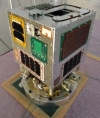
|
HORYU-2
HORYU-II
#38340
(2012-025D) |
HORYU-II was built by
students at the KIT (Kyushu Insitute of Technology)
in Japan. It's size is 350x310x315mm and his weight
is 7.1 kg. Horyu-2 was launched together with JAXA,
a Japanses climate observation satellite, on May17th
2012 at 16:39 UTC into a sun-synchronous 680km orbit
with an inclination of 98°. Shortly after successful
separation from the launcher, CW downlink signals were
received and decoded by multiple stations around the
world. The satellite uses the callsign JG6YBW and transmits
CW (20wpm Morse) or packet radio (1200bps AX.25 FSK)
on 437.375 MHz. |
May
17th 2012 |
 Enclosed
CW signal was received and recorded on May 18th
2012 at 14:00 GMT by DD1US. Enclosed
CW signal was received and recorded on May 18th
2012 at 14:00 GMT by DD1US.
|
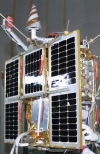
|
RS-40
Yubileiny-2
MiR
#38735
(2012-041C) |
Yubileiny 2 or also called
RS-40 has a weight of 65 kg and was launched on a Rockot
vehicle on July 27th 2012 from Plesetsk Cosmodrome in
Baikonur. The instruments comprising RS-40 as well as
the research mission were built by students and research
staff of the Siberian State Aerospace University. The
satellite structure itself was manufactured by Academician
M.F. Reshetnev Information Satellite Systems (ISS).
The 3rd name Mir is in recognition of Mikhal Reshetnev,
the founder and first director of the company ISS.
RS-40 transmits on 435.265 MHz as well as 435.365 MHz
a PM (phase modulated) data signal with 4800 bps (Manchester
encoded) or a CW signal. Maik Hermenau was the first
who reported its reception on July 28th. |
July
27th 2012 |
  Enclosed
audio signal was received on July 29th
2012 at 12:30h UTC on 435.365 MHz in FM by DD1US. It
is the digital PM signal and presumably only active,
when the satellite is in range of the base-station in
Russia. The corresponding spectrum plot is attached. Enclosed
audio signal was received on July 29th
2012 at 12:30h UTC on 435.365 MHz in FM by DD1US. It
is the digital PM signal and presumably only active,
when the satellite is in range of the base-station in
Russia. The corresponding spectrum plot is attached.
During the subsequent pass at 14:30h
UTC the satellite was transmitting a digital PM signal
on its second downlink at 435.265 MHz. |
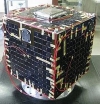
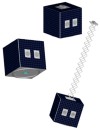
|
PROITERES
JL3YZK
#38756
(2012-047B) |
Proiteres (Project of
Osaka Institute of Technology Electric-Rocket-Engine
onboard Small Space Ship) is a 30cm3
cubesat with a weight of 15kg. It was built by Osaka
Institute of Technology. It was launched together with
SPOT6 and mRESINS on September 9th
2012 at 04:21 UTC on Polar Satellite Launch Vehicle-C21
(PSLV-C21). It was the 100th mission of the Indian space
agency. The overall objective is to demonstrate powered
flight on a nanosatellite with an electro-thermal PPT
(Pulsed Plasma Thruster) device. Proiteres will use
the callsign JL3YZK when transmitting beacon and telemetry
signals on 437.485 MHz using its CW & FM/BFSK (binary
FSK) transmitter with 10 W output power. It also includes
as digital still camera and will transmit pictures on
the 70cm band downlink. |
Sept.
9th 2012 |
  Enclosed
audio signal was received on September 9th
2012 at 09:15h UTC on 437.485 MHz in FM. It is the CW
signal with telemetry. The corresponding spectrum plot
is attached. Enclosed
audio signal was received on September 9th
2012 at 09:15h UTC on 437.485 MHz in FM. It is the CW
signal with telemetry. The corresponding spectrum plot
is attached.
|
  Enclosed
audio signal was received on September 9th
2012 at 12:27h UTC on 437.485 MHz in FM. It is the CW
signal with telemetry. The corresponding spectrum plot
is attached. Enclosed
audio signal was received on September 9th
2012 at 12:27h UTC on 437.485 MHz in FM. It is the CW
signal with telemetry. The corresponding spectrum plot
is attached.
|
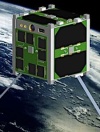
|
BEESAT-2
#39136
(2013-015G) |
BEESAT-2
(Berlin Experimental and Educational Satellite) is a
cubesat-sized vehicle carries a technology experiment
using gyros and sensors for precise orientation. The
1kg satellite was built by the Technical University
of Berlin/Germany.
The OSSI-1, BEESAT-2, BEESAT-3 and
SOMP amateur radio CubeSats lifted off on a Soyuz-2-1a
with research satellites Bion-M1, AIST and Dove-2 from Launch
Complex 31 at Baikonur in Kazakhstan on Friday, April
19th 2013 at 1000 UTC. BEESAT-2
is expected to be released on April 21st
2013.
BEESAT-2 has a 4800Bd GMSK/Mobitex
downlink in the 70cm Amateur Radio band at 435.950 MHz.
The downlink can also be switched to 9600Bd. The output
power is 0.5 Watts. BeeSat-2 will use the callsign DP0BEF. |
Apr.
19th 2013 |
 Enclosed
recording of the CW beacon and GMSK transmissions of
BEESAT-2 was received on 435.950 MHz on April 21st
2013 at 13:13 UTC. Recorded and kindly provided by Mike
DK3WN. Enclosed
recording of the CW beacon and GMSK transmissions of
BEESAT-2 was received on 435.950 MHz on April 21st
2013 at 13:13 UTC. Recorded and kindly provided by Mike
DK3WN.
|
 Enclosed
signal from BEESAT-2 was received on March 31st
2015 at 09:34 UTC by Francisco EA7ADI . Recording kindly
provided by Francisco EA7ADI. Enclosed
signal from BEESAT-2 was received on March 31st
2015 at 09:34 UTC by Francisco EA7ADI . Recording kindly
provided by Francisco EA7ADI.
|

|
BEESAT-3
#39134
(2013-015E) |
BEESAT-3
(Berlin Experimental and Educational Satellite) is cubesat-sized
vehicle that will test high-speed data links (up to
1MB/s). The 1kg satellite was built by the Technical
University of Berlin/Germany.
The OSSI-1, BEESAT-2, BEESAT-3 and
SOMP amateur radio CubeSats lifted off on a Soyuz-2-1a
with research satellites Bion-M1, AIST and Dove-2 from Launch
Complex 31 at Baikonur in Kazakhstan on Friday, April
19th 2013 at 1000 UTC. BEESAT-3
is expected to be released on April 21st
2013.
BEESAT-3 has a 4800Bd GMSK/Mobitex
downlink in the 70cm Amateur Radio band at 435.950 MHz.
The downlink can also be switched to 9600Bd. The output
power is 0.5 Watts. BEESAT-3 will possibly also transmit
in S-Band. BEESAT-3 has the callsign DP0BEG.
No signals from the spacecraft were
ever received. |
Apr. 19th
2013 |
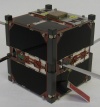
|
SOMP
SOMP-1
#39135
(2013-015F) |
The
Student Oxygen Measurement Project (SOMP) is a 1kg cubesat
developed by students of the Technische Universität
Dresden, Germany, organized in the Students’ Research
Group for Spacecraft Engineering in Dresden (STARD).
SOMP is a standard sized single CubeSat with one payload
side and five sides with two solar cells each.
SOMP lifted
off on a Soyuz-2-1a with research satellites Bion-M1,
AIST and Dove-2 as well as other amateur radio CubeSats
from Launch Complex 31 at Baikonur in Kazakhstan
on Friday, April 19th 2013
at 1000 UTC. SOMP is expected to be released on April
21st 2013.
SOMP has a downlink in
the 70cm Amateur Radio band at 437.485 MHz including CW,
1200Bd
BPSK, 9600Bd AX25 FSK and 400bit/s BPSK (like AO40).
SOMP will us the callsign DP0TUD. |
Apr.
19th 2013 |
 Enclosed
recording of the CW beacon of SOMP transmitting "DP0TUD
ABH XCVAQADC <AR>" was received
on 437.485 MHz on April 21st
2013 at 13:15 UTC. Recorded and kindly provided by Mike
DK3WN. Enclosed
recording of the CW beacon of SOMP transmitting "DP0TUD
ABH XCVAQADC <AR>" was received
on 437.485 MHz on April 21st
2013 at 13:15 UTC. Recorded and kindly provided by Mike
DK3WN.
|
 Enclosed
recording of the high speed CW beacon of SOMP was received
on 437.485 MHz on April 21st
2013 at 13:19 UTC. Recorded and kindly provided by Mike
DK3WN. Enclosed
recording of the high speed CW beacon of SOMP was received
on 437.485 MHz on April 21st
2013 at 13:19 UTC. Recorded and kindly provided by Mike
DK3WN.
|
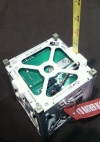
|
PhoneSat
(ID A)
GRAHAM
KJ6KRW-2
#39146
(2013-016E)
PhoneSat (ID B)
BELL
KJ6KRW-1
#39142
(2013-016A)
PhoneSat
ALEXANDER
KJ6KRW
#39144
(2013-016C) |
Three
PhoneSat cubesats are now on-orbit following the launch
of the Orbital Sciences Corporation Antares(TM) rocket
from NASA’s Wallops Flight Facility (WFF) in eastern
Virginia. They were launched on April 21st
2013.
All three of
the Phonesat cubesats carries an amateur radio payload
on 437.425 MHz. Each cubesat will transmit during individual
timeslots. All three satellites transmit using AFSK
(1200 bps) modulation, AX.25 packet coding and have
vertical linear polarization. The two PhoneSat 1.0 satellites,
Graham and Bell, transmit with a periodicity of respectively
28 seconds and 30 seconds. The PhoneSat 2.0 beta satellite,
Alexander, transmit with a periodicity of 25 seconds.
 All
three PhoneSats have been successfully received. GRAHAM
and BELL transmitted data packets comprising a picture.
Pictures have been restored successfully. Enclosed pictures
are a courtesy of www.phonesat.org. All
three PhoneSats have been successfully received. GRAHAM
and BELL transmitted data packets comprising a picture.
Pictures have been restored successfully. Enclosed pictures
are a courtesy of www.phonesat.org.
The orbit is
very low (270km x 300km, 51.6deg) and the cubesats are
expected to only remain on-orbit for two weeks. The
satellites are battery powered with no additional charging
from solar cells. PhoneSat Bell was the last who decayed,
which happened on May 10th
around 00:58 UTC. |
Apr. 21st
2013 |
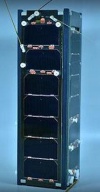
|
TurkSat-3USat
YM2RTU
#39152
(2013-018C) |
TURKSAT-3USAT is a three
unit CubeSat built jointly by TURKSAT and the Istanbul
Technical University (ITU).It was launched on April
26th 2013 at 0413 UTC on a
CZ-2D rocket from the Jiuquan Space Center in China.
The power is provided using solar panels and lithium
polymer batteries together with super capacitors. The
target orbit is a circular 680km low earth orbit (LEO).
Satellite stabilization is accomplished using passive
magnetic attitude control system with hysteresis rods.
There is a camera payload to take images of the Earth.
The communication system includes
a UHF CW beacon at 437.220 MHz using the callsign YM2RTU
and an inverting VHF/UHF linear transponder built by
TAMSAT, the Turkish Amateur Satellite Technologies Organization.
The SSB/CW transponder has an uplink at 145.940-145.990
MHz and a downlink at 435.200-435.250 MHz. |
Apr.
26th 2013 |
 The TurkSat
CW beacon has been successfully received by PE0SAT on
April 26th 2013 at 10:44 UTC.
Recording kindly provided by Jan PE0SAT. The TurkSat
CW beacon has been successfully received by PE0SAT on
April 26th 2013 at 10:44 UTC.
Recording kindly provided by Jan PE0SAT.
|
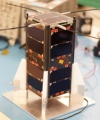
|
CubeBug-1
Capitan Beto
#39153
(2013-018D) |
CubeBug-1
is a 2U-Cubesat developed in Argentina and was launched
on April 26th 2013 at 0413
UTC on a CZ-2D rocket from the Jiuquan Space Center
in China. This is the first technology demonstration
mission for a new CubeSat platform design (mechanics,
hardware and software) intended to be released as Open
Source and Open Hardware for its use in Amateur projects,
University projects and research labs.
CubeBug-1 transmits a beacon including
telemetry on 437.445 MHz in 1200Bd AFSK AX.25 with 1
Watt output power. The callsign will be CUBEB. |
Apr.
26th 2013 |
 Enclosed
signal from CubeBug-1 was received on April 26th
2013 at 20:08 UTC on 437.418 MHz by PE0SAT. Recording
kindly provided by Jan PE0SAT. Enclosed
signal from CubeBug-1 was received on April 26th
2013 at 20:08 UTC on 437.418 MHz by PE0SAT. Recording
kindly provided by Jan PE0SAT.
|
 Jan PE0SAT
received CubeBug-1 also on May 14th
2013 at 09:47 UTC on 437.443 MHz. Recording kindly provided
by Jan PE0SAT. Jan PE0SAT
received CubeBug-1 also on May 14th
2013 at 09:47 UTC on 437.443 MHz. Recording kindly provided
by Jan PE0SAT.
|
 Enclosed
signal from CubeBug-1 at 437.445 MHz was received on
December 26th 2013 at 22:16
UTC by Paul Marsh. Recording kindly provided by Paul
M0EYT. Enclosed
signal from CubeBug-1 at 437.445 MHz was received on
December 26th 2013 at 22:16
UTC by Paul Marsh. Recording kindly provided by Paul
M0EYT.
|
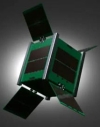
|
LO-75
CAPE-2
CAPE II
#39382
(2013-064C) |
CAPE-2
(Cajun Advanced Picosat Experiment ) or Louisiana OSCAR
75
is a 1 kg Cubesat built by the University of Louisiana
at Lafayette. The
mission of this satellite is to gather data while orbiting
in space and
transmit this data to the ground station on the UL at
Lafayette campus.
The team of engineering students will run experiments
and maintain
the satellite while in orbit. CAPE-2 transmits telemetry
in FM
(AX25) and CW at 145.825 MHz using the callsign W5UL.
CAPE-2
also has a designated UHF downlink at 437.325 MHz.
The beacon
interval varies depending the mode of the satellite:
Green
Mode Interval: 2 Minutes
Orange Mode Interval:
4 Minutes
Red
Mode Interval: 6 Minutes
In CW mode the following
data format is used:
Callsign / Sat. Name / Mode
of Sat. / Unregulated Bus Voltage.
In AX25 mode
the following data format is used:
Callsign / Sat.
Name / Beacon ID / Mode of Sat. / Sat. Time / Unregulated
Bus Voltage / Health Code / no. of Beacons since last
reset / VHF TX Temp. / UHF TX Temp. / Website URL.
Besides the data transmission Cape-2 also features a digipeater,
text to speech operation, a simplex repeater,
email and tweet functions. |
Nov.
20th 2013 |
 Enclosed
CW signal from LO-75 was received on December 3rd
2013 at 08:29 UTC on 145.825 MHz, recorded and kindly
provided by Roland PY4ZBZ. Enclosed
CW signal from LO-75 was received on December 3rd
2013 at 08:29 UTC on 145.825 MHz, recorded and kindly
provided by Roland PY4ZBZ.
|
 Enclosed
synthesized voice downlink from LO-75's text-to-speech
function was received on December 3rd
2013 at 08:29 UTC on 145.825 MHz, recorded and kindly
provided by Roland PY4ZBZ. Enclosed
synthesized voice downlink from LO-75's text-to-speech
function was received on December 3rd
2013 at 08:29 UTC on 145.825 MHz, recorded and kindly
provided by Roland PY4ZBZ.
|
 Enclosed
synthesized voice downlink "Hi Roland PY4ZBZ, 73
from CAPE-2" from LO-75's text-to-speech function
was received on December 18th
2013 on 145.825 MHz by PY4ZBZ. Recorded and kindly provided
by Roland PY4ZBZ. Enclosed
synthesized voice downlink "Hi Roland PY4ZBZ, 73
from CAPE-2" from LO-75's text-to-speech function
was received on December 18th
2013 on 145.825 MHz by PY4ZBZ. Recorded and kindly provided
by Roland PY4ZBZ.
|
 Enclosed
synthesized voice downlink"Hello Papa Yankee Four
Zulu Bravo Zulu from CAPE-2" from LO-75's text-to-speech
function was received December 26th
2013 at 21:42 UTC on 145.825 MHz by PY4ZBZ. Recorded
and kindly provided by Roland PY4ZBZ. Enclosed
synthesized voice downlink"Hello Papa Yankee Four
Zulu Bravo Zulu from CAPE-2" from LO-75's text-to-speech
function was received December 26th
2013 at 21:42 UTC on 145.825 MHz by PY4ZBZ. Recorded
and kindly provided by Roland PY4ZBZ.
|
 Enclosed
recording demonstrates nicely the voice repeater capabilities
of CAPE-2. Roland PY4ZBZ activated the voice repeater
mode and recording a greeting message which was then
played back by CAPE-2. You can hear "Cape-2 voice
repeater is now recording. Playback from the Cape-2
voice repeater. Hello CAPE-2 PY4ZBZ. Thanks
for using the Cape-2 voice repeater." Recorded
on February 24th 2014 during
orbit #1470 on 145.825 MHz and kindly provided by Roland
PY4ZBZ. Enclosed
recording demonstrates nicely the voice repeater capabilities
of CAPE-2. Roland PY4ZBZ activated the voice repeater
mode and recording a greeting message which was then
played back by CAPE-2. You can hear "Cape-2 voice
repeater is now recording. Playback from the Cape-2
voice repeater. Hello CAPE-2 PY4ZBZ. Thanks
for using the Cape-2 voice repeater." Recorded
on February 24th 2014 during
orbit #1470 on 145.825 MHz and kindly provided by Roland
PY4ZBZ.
|
 On April
26th 2014 Davide IW0HLG received
the voice signal of CAPE-2 on 145.822 MHz. Recording
kindly provided by Davide IW0HLG. On April
26th 2014 Davide IW0HLG received
the voice signal of CAPE-2 on 145.822 MHz. Recording
kindly provided by Davide IW0HLG.
|
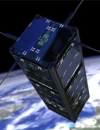
|
Triton-1
#39427
(2013-066M) |
Triton-1 is the first
3U CubeSat of a series of 2, built by ISIS-BV (Innovative
Solutions in Space BV) in Delft (NL). This 3.0 kg satellite
was launched on November 21st
2013 and is a radio science mission which aims to test
an experimental advanced AIS (Automatic Identification
System) receiver. Telemetry transmission on 145.815
MHz (9600Bd RC-BPSK) includes housekeeping telemetry,
payload telemetry as well as received AIS messages.
A second VHF-downlink frequency allocate to it is 145.860
MHz. Triton-1 also features a S-band downlink at 2408
MHz. After the 3 month science mission it is planned
to reconfigure Triton-1 to U/V FM to DSB repeater mode
and open it for amateur use. |
Nov.
21st 2013 |
 Enclosed
signal from Triton-1 at 145.815 MHz was received on
December 26th 2013 at 22:44
UTC by Paul Marsh. Recording kindly provided by Paul
M0EYT. Enclosed
signal from Triton-1 at 145.815 MHz was received on
December 26th 2013 at 22:44
UTC by Paul Marsh. Recording kindly provided by Paul
M0EYT.
|
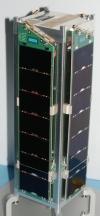

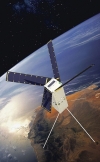
|
Delfi-n3Xt
#39428
(2013-066N) |
Delfi-n3Xt
is a 3U cubesat from Delft University of Technology
in NL. It is the successor of Delfi-C3, which was launched
in April 2008.
Delfi-n3Xt was
successfully launched on November 21st
2013 on a Russian Dnepr-rocket.
The primary
telemetry downlink is at 145.870 MHz (2400 Baud BFSK,
AX.25, 200mW). In addition it features a high speed
S-band downlink at 2405 MHz (20-500 kbit/s, MSK, 125
mW).
After the primary
objectives of the mission are accomplished the satellite
will be made available to radio amateurs. The 145.870
MHz beacon will be active in CW when the 40kHz wide
U/V inverting linear transponder with an uplink band
of 435.570 - 435.530 MHz and a downlink band of 145.880
- 145.920 MHz is activated.
Delfi-n3Xt also
includes a 145.930 MHz 1200Bd AFSK downlink. |
Nov.
21st 2013 |
 Enclosed recording
wase made on December 21st 2013
at 09:56 UTC on 145.870 MHz first in NFM
and then in USB mode by DD1US. Enclosed recording
wase made on December 21st 2013
at 09:56 UTC on 145.870 MHz first in NFM
and then in USB mode by DD1US.
|

|
GOMX-1
#39430
(2013-066Q) |
GOMSpace's GOMX-1
is a student built amateur radio radio satellite. This
Cubesat (2U structure) has a weight of 2 kg and was
built by more than 15 students at Aalborg University
in Denmark and flown under the auspices of a Government
research grant covering space related radio research.
The objective of the satellite is to qualify a number
of subsystems and provide extensive in-flight data.
The downlink is at 437.250 MHZ with
1k2, 2k4, 4k8 or 9k6 GMSK modulation. |
Nov.
21st 2013 |
  Enclosed recording
and waterfall plot were made on December 11th 2013 at
21:35 UTC on 437.250
MHz in FM mode by DD1US. Enclosed recording
and waterfall plot were made on December 11th 2013 at
21:35 UTC on 437.250
MHz in FM mode by DD1US.
|
  Enclosed
signal from GOMX-1 at 437.250 MHz was received on December
26th 2013 at 22:50 UTC by Paul
Marsh. Recording and waterfall plot kindly provided
by Paul M0EYT. Enclosed
signal from GOMX-1 at 437.250 MHz was received on December
26th 2013 at 22:50 UTC by Paul
Marsh. Recording and waterfall plot kindly provided
by Paul M0EYT.
|
 Enclosed recording
was made on March 8th 2014 at 10:12 UTC on 437.250
MHz in FM mode by DD1US. Enclosed recording
was made on March 8th 2014 at 10:12 UTC on 437.250
MHz in FM mode by DD1US.
|
 Enclosed
signal from GOMX-1 was received on May 1st
2015 at 08:51 UTC by Francisco EA7ADI . Recording kindly
provided by Francisco EA7ADI. Enclosed
signal from GOMX-1 was received on May 1st
2015 at 08:51 UTC by Francisco EA7ADI . Recording kindly
provided by Francisco EA7ADI.
|
 Enclosed
CW signal from GOMX-1 was received on September 8th
2016 at 17:58 UTC by Francisco EA7ADI . Recording kindly
provided by Francisco EA7ADI. Enclosed
CW signal from GOMX-1 was received on September 8th
2016 at 17:58 UTC by Francisco EA7ADI . Recording kindly
provided by Francisco EA7ADI.
|
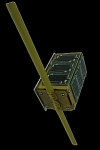
|
MO-76
Morehead OSCAR-76
$50SAT
Eagle2
#39436
(2013-066W) |
$50SAT has been a collaborative
education project between Professor Bob Twiggs,
Morehead State University and 3 radio amateurs, Howie
DeFelice, AB2S, Michael Kirkhart, KD8QBA, and Stuart
Robinson, GW7HPW. The primary purpose of $50SAT (Eagle2)
was to create a cost effective platform for engineering
and science students to use for developing real world
skills. The very small pocketcube (5x5x5.7cm) with a
weight of only 0.2 kg has no precision mechanical parts
and can be built from locally obtained sheet metal.
It was successfully launched from Dombarovsky Air Base
in Russia on Nov. 21st 2013
07:11 UTC. The satellite went operational shortly after
it was released from Unisat-5. It transmits a slow Morse
FM beacon as well as FSK RTTY on 437.505MHz. It has
been received already during its first pass over UK. |
Nov.
21st 2013 |
 This is from the
5th of the 5 available FM Morse beacons transmitted,
and is the one which can be changed via an uplink command. In
May 2014 it was changed to "73 AA2TX" to honor
Tony Monteiro, AA2TX, the AMSAT-NA VP f Engineering
who died on March 26th 2014.
It was recorded on May 18th 2014 at 17:01
UTC at the AMSAT demo booth at the 2014 Dayton Hamvention
(gridsquare EM79). Recording kindly provided by Michael
Kirkhart, KD8QBA. This is from the
5th of the 5 available FM Morse beacons transmitted,
and is the one which can be changed via an uplink command. In
May 2014 it was changed to "73 AA2TX" to honor
Tony Monteiro, AA2TX, the AMSAT-NA VP f Engineering
who died on March 26th 2014.
It was recorded on May 18th 2014 at 17:01
UTC at the AMSAT demo booth at the 2014 Dayton Hamvention
(gridsquare EM79). Recording kindly provided by Michael
Kirkhart, KD8QBA.
|
 This is from a daytime
pass near the QTH of KD8QBA (gridsquare EN82), and was
recorded by Michael on May 20th 2014 at 15:49 UTC using
his FT-817ND operating in LSB mode. This is from a daytime
pass near the QTH of KD8QBA (gridsquare EN82), and was
recorded by Michael on May 20th 2014 at 15:49 UTC using
his FT-817ND operating in LSB mode.
 It
contains the transmission of RTTY telemetry. Enclosed
is also a screen capture of fl-digi decoding the RTTY
telemetry (8 bit, 1 stop bit, 100 baud, 630 Hz shift).
Recording and screen capture kindly provided by Michael
Kirkhart, KD8QBA. It
contains the transmission of RTTY telemetry. Enclosed
is also a screen capture of fl-digi decoding the RTTY
telemetry (8 bit, 1 stop bit, 100 baud, 630 Hz shift).
Recording and screen capture kindly provided by Michael
Kirkhart, KD8QBA.
|
 On January
3rd 2015 at 11:59 UTC Francisco
EA7ADI received the RTTY signal of EAGLE-2. Recording
kindly provided by Francisco EA7ADI. On January
3rd 2015 at 11:59 UTC Francisco
EA7ADI received the RTTY signal of EAGLE-2. Recording
kindly provided by Francisco EA7ADI.
|
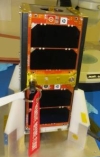
|
LO-74
LUSAT-OSCAR-74
CubeBug-2
Manolito
#39440
(2013-066AA) |
Cubebug-2 carries an
amateur radio AX.25 packet radio digipeater. It is the
second technology demonstration mission for a new 2U
CubeSat platform design (mechanics, hardware and software)
intended to be released as Open Source and Open Hardware
for its use in Amateur projects, University projects
and Research labs. This project is sponsored by the
Argentinian Ministry of Science, Technology and Productive
Innovation.
Cubebug-2 transmits its telemetry
in AX.25 protocol on 437.445 MHz with 1200bd AFSK or
9600bps FSK/GMSK. The callsign is CUBEB2-6. |
Nov.
21st 2013 |
 Jan PE0SAT
received the 9600 GMSK signal from Cubebug-2 on November
21st 2013 at 11:58 UTC on 437.445
MHz. Recording kindly provided by Jan van Gils PE0SAT. Jan PE0SAT
received the 9600 GMSK signal from Cubebug-2 on November
21st 2013 at 11:58 UTC on 437.445
MHz. Recording kindly provided by Jan van Gils PE0SAT.
|
 On
January 14th 2014 during orbit
#841 of LUSAT-OSCAR-74 enclosed spectrum of the 9600bd
downlink was recorded and kindly provided by Roland
PY4ZBZ. On
January 14th 2014 during orbit
#841 of LUSAT-OSCAR-74 enclosed spectrum of the 9600bd
downlink was recorded and kindly provided by Roland
PY4ZBZ.
|
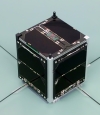
|
AO-73
AMSAT-OSCAR-73
FUNcube-1
#39444
(2013-066AE) |
FUNcube-1
was successfully launched on November 21st
2013 and is an educational single CubeSat project with
the goal of enthusing and educating young people about
radio, space, physics and electronics. It supports the
educational Science, Technology, Engineering and Math
(STEM) initiatives. FUNcube features a 145.935 MHz telemetry
beacon (1200bps BPSK) that provides a strong signal
for the primary and secondary pupils to receive. Measuring
just 10cm x 10cm x 10cm, and with a mass of less than
1kg, FUNcube-1 also carries a linear transponder.
This UHF (435.150 - 435.130 MHz) to VHF (145.950 - 145.970
MHz) linear transponder with approx 500mW PEP output
power is used by Radio Amateurs worldwide for SSB and
CW communications.
It was reported by Bob WB4SON
that up- and downlink frequencies show an offset of
18kHz versus the planned scheme. Without taking into
account any doppler-shift an uplink signal at 435.16048
MHz should be received at a downlink frequency of 145.95752
MHz. |
Nov.
21st 2013 |
 Enclosed
signal from FUNcube-1was received on November 22nd
2013 at 22:51 UTC on 145.935 MHz. by Marco Bauer. Recording
kindly provided by Marco Bauer. Enclosed
signal from FUNcube-1was received on November 22nd
2013 at 22:51 UTC on 145.935 MHz. by Marco Bauer. Recording
kindly provided by Marco Bauer.
|
 Enclosed
signals of the linear transponder downlink were received
and recorded on December 10th
2013 at 20:42 UTC by DD1US. Enclosed
signals of the linear transponder downlink were received
and recorded on December 10th
2013 at 20:42 UTC by DD1US.
|
Picture |
Satellite
#NORAD |
Description |
Launch Date |